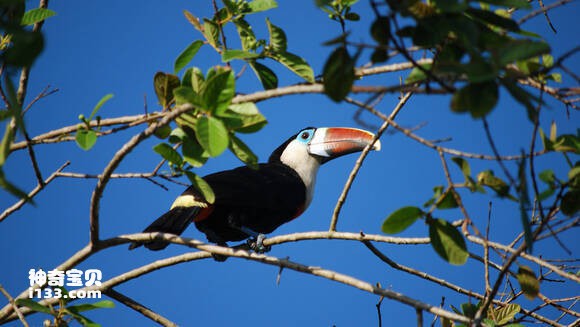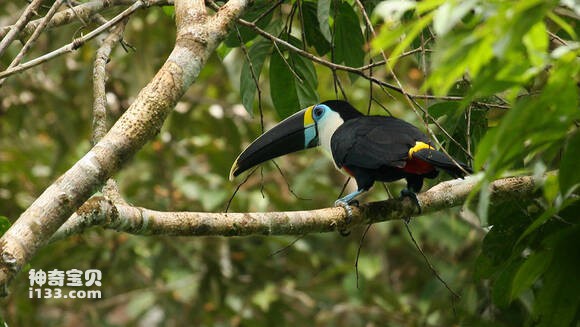Ramphastos tucanus
IUCN
LCBasic Information
Scientific classification
- name:Ramphastos tucanus
- Scientific Name:Ramphastos tucanus,White-throated toucan
- Outline:Climbing birds
- Family:
Vital signs
- length:55-60cm
- Weight:No textual research information is available
- lifetime:No textual research information is available
Feature
Distribution and Habitat
It is found in South America (Colombia, Venezuela, Guyana, Suriname, Ecuador, Peru, Bolivia, Paraguay, Brazil, Chile, Argentina, Uruguay, and the Malvinas Islands (also known as the Falkland Islands).
The red-billed toucan lives mainly in lowland rain forests, sometimes in open areas with sparse trees nearby. They are rarely seen above 1,700 metres above sea level.
Appearance
The red-billed toucan is a medium-sized climbing bird with a shape slightly like a hornbill and a body length of 55 to 60 cm. The male's beak is larger than the female's. The parts below the abdomen and tail are black, the throat and chest are white, and the anal tail and chest are red. The cover of the tail is yellow. The eye skin is blue, the base of the beak is yellow and blue in a circle, and there is a yellow streak across the middle of the upper beak from the cusp to the base of the beak. The nostrils of the adult bird are hidden under the base of the beak. A bird's beak is actually very light, not nearly as heavy as it looks. The outside is a thin sheath of keratin, the inside is hollow, but there are many thin bone support rods staggered. The tongue of the red-billed toucan is very long, the margin of the beak is clearly serrated, and there is no mouth beard around the base of the beak. The skin on the exposed part of the face and jaw is usually brightly colored.
Details
The red-billed toucan is known as Ramphastos tucanus or White-throated toucan, and has two subspecies, the southern and western named subspecies R. t. tucanus, and the eastern and northern South American 鵎 touvieri. Both subspecies were initially considered separate species, but because they differ only in the color of their beaks, and the two interbreed when close to each other, they are classified as separate subspecies. The validity of the Bolivian subspecies R. t. inca has been questioned and may be a mixture of the two subspecies.

红嘴巨嘴鸟鸟鸣声嘶哑低沉。红嘴巨嘴鸟杂食性,以果实、种子和昆虫为食,有时也掠夺小鸟的巢穴,吃掉卵和雏鸟。

The red-billed Toucan nests in tree holes, and the preferred holes are of good wood, the opening width is just enough for the adult bird to drill into, and the hole is 17 cm ~ 2 meters deep. The presence of suitable burrows near the root of the tree will also attract birds that normally nest in high places to nest near the ground. - Lay 2 to 4 eggs. Smooth white eggs are piled in unlined holes and hatch in about 16 days. The hatchlings are completely naked and need at least three weeks to open their eyes, and after hatching, it takes more than 50 days for the chicks to live their lives independently in the leaf cluster.
Listed on the IUCN Red List of Threatened Species (IUCN) for 2016 ver 3.1 - Vulnerable (VU).
Listed in Appendices I, II and III of the Convention on International Trade in Endangered Species of Wild Fauna and Flora (CITES) 2019 edition Appendix II.
Protect wild animals and eliminate wild meat.
Maintaining ecological balance is everyone's responsibility!








